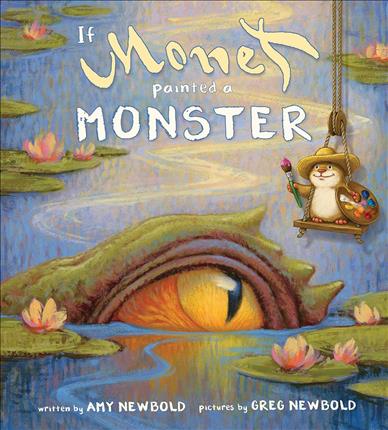| If Monet painted a monster (Reimagined masterpiece series) Author: Newbold, Amy | ||
| Price: $8.16 | ||
Summary:
An engaging hamster reimagines some iconic art masterpieces with monsters in them.
| Illustrator: | Newbold, Greg |
Full Text Reviews:
Booklist - 10/15/2019 How would a famous artist paint a monster? In this third outing (If Picasso Painted a Snowman, 2017; If Da Vinci Painted a Dinosaur, 2018), Amy and Greg Newbold imagine how 16 acclaimed artists would wield their distinct styles in creating imaginative (but never too scary) monsters. Iconic masterpieces are reimagined: readers see a menacing beast eyeing the customers in Hopper's diner, Whistler's monster sits demurely with her tentacles peeking out of the bottom of her gown, and a group of ghouls frolic merrily at one of Toulouse-Lautrec's Monstre Bals. The best is saved for last: a slimy sea serpent slithers through Monet's beloved water lilies. The illustrations go for laughs, but overall the updated versions remain faithful to the composition and palette of their originals. Appended brief biographies provide basic facts to whet further interest. Kids love monsters, kids love to draw, and, after being introduced to these silly reincarnations, kids should begin to at least like art—whether they're attracted to Arcimboldo's fanciful sixteenth-century vegetable collages or wowed by Basquiat's exuberant graffiti. - Copyright 2019 Booklist.
School Library Journal - 12/01/2019 Gr 1–3–With the Newbolds' third excursion into art history for children, a curious hamster provides a monster safari through some of the most famous works of American realist Edward Hooper, the surrealism of Dorothea Tanning, Jean-Michel Basquiat, and many more. The story begins by asking readers to conjure up the mental picture of a monster, and goes on to explore how such a creature might appear if imposed on the landscape of various works of art. Rather than Whistler's Mother, viewers are introduced to Whistler's monster—a Lovecraftian sea-monster in a rocking chair. Vegetables are assembled into a monstrous still life to stand for Giuseppe Arcimboldo's portrait of Rudolph II. The example of René Magritte does not seem to channel a specific piece, instead incorporating his themes into a ghoulish work of surrealism. While the works themselves, which appear to be rendered digitally, lack some of the painterly style and hallmarks of the originals, the monsters are integrated so that it is often difficult to distinguish which elements are part of the original; perhaps the best example being Franz Kline's abstract monster in dark strokes. The last page offers children an opportunity to draw their own monster and the back matter explains more about the life and signature style of each artist represented. VERDICT A clever and somewhat spooky introduction to famous artists and their signature works for early elementary students.—Kelly Topita, Anne Arundel County Public Library, MD - Copyright 2019 Publishers Weekly, Library Journal and/or School Library Journal used with permission.


